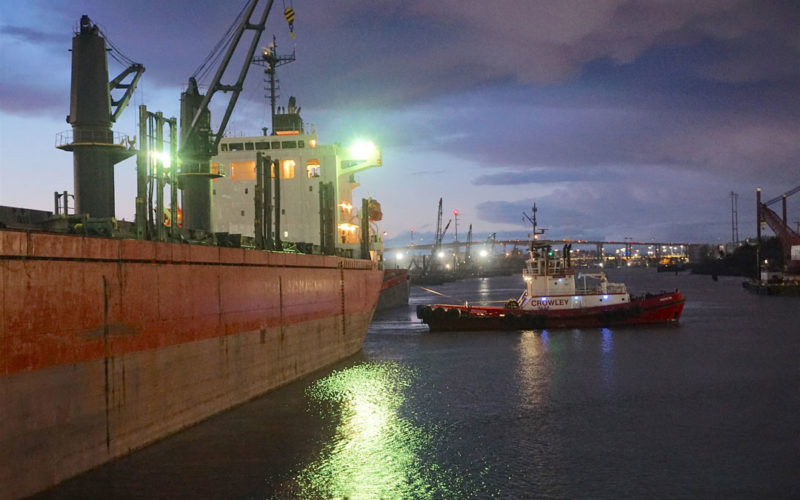Two Crowley Maritime tugboats guided the bulk carrier Forest Trader around the final turn in Seattle’s Duwamish Waterway, and with that the most difficult part of the job lay behind them. The open waters of Elliott Bay were straight ahead.
“Once you get past the corner of Fisher’s Mill, everyone kind of breathes a little easier,” said Capt. Doug Wingate, captain of the Crowley tug Guard, referring to the former flour mill at the southwest corner of Harbor Island.
For the past hour, the 5,500-hp sister tugs Guard and Protector had guided Forest Trader stern-first down the narrow Duwamish. Guard, positioned forward of the bow, kept the empty bulker in the center of the channel. Protector, working centerline aft, pulled the ship along.
Crowley performs this type of ship-assist work once or twice a month in Seattle, and it requires skill, finesse and constant communication between the pilot and the tug captains. The Duwamish is lined with barges and maritime infrastructure — several marinas extend into the waterway, and there are back-to-back bridges — leaving little room for error.
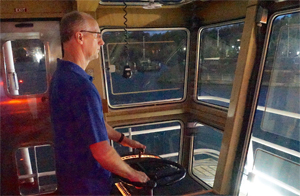 |
|
Capt. Doug Wingate, a longtime Crowley captain, steers the tugboat Guard while assisting the bulk carrier Forest Trader as it approaches a series of bridges. |
“The main challenge up there is just the space that you have to work in,” said Shannon Graham, Guard’s chief mate. “You have a couple of choke points. There is the rail bridge and the Spokane Street Bridge that narrows things down. You might have just 15 or 20 feet on either side.”
Guard got underway at about 1715 on a drizzly late February afternoon from Crowley’s home base at Pier 17. The voyage took place a day before authorities announced the first coronavirus death in a Seattle suburb, signaling the first major outbreak in the United States. Still, by this point pilots and other mariners in major West Coast ports were already taking precautions against the virus.
Protector and Guard were built in the late 1990s at Nichols Brothers Boat Builders based on a design from Guido Perla and Associates of Seattle. The 120-foot tugs are outfitted with two Caterpillar 3606 2,250-hp engines turning Voith Schneider cycloidal propellers. Over the years, Crowley also has operated Protector-class tugs in California’s busy ports.
Graham, who has spent 21 years working for Crowley and the past 13 as mate, said the vessels are well-suited for ship assist and escort. Much of Crowley’s work in Puget Sound consists of escorting tankers and assisting containerships. The company competes with Foss Maritime for most commercial ship-assist work in the sound.
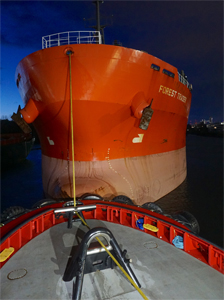 |
|
A tight responsive line is deployed by Guard to control Forest Trader’s bow during the sternward transit out the Duwamish. |
“(Guard) is highly maneuverable, so it is really good for ship assist to get into tight quarters,” Graham said. “For turning a ship that’s going above 3 knots, you can use the skeg and go indirect, and it lays the boat over and you have the weight of the boat, and the skeg, producing that tonnage.”
The trip from Pier 17 to the Duwamish is a short one. Graham steered the vessel around Harbor Island, home to Seattle’s main container port and much of its maritime infrastructure. The tug rounded the island’s northwest corner, past Vigor’s massive shipyard, then slowed as it approached the Spokane Street swing bridge to wait for Protector to arrive from Tacoma.
“Anytime you are working together and you have to go through a bridge, you want to go together so they don’t have to open twice and stop traffic, especially at 5 o’clock,” Graham said.
Before long the Spokane Street Bridge and narrower Duwamish River Bridge, which carries rail traffic, were open. The Western Towboat tugs Mariner and Western Titan, which were outbound on the Duwamish with the cargo barge Anchorage Trader, held up south of the bridges so the Crowley tugs could pass. Guard and Protector returned the favor soon afterward, moving into a turning basin while the Western tugs chugged toward Elliott Bay with the loaded barge headed to Alaska.
 |
|
Protector helps pull the bulk carrier away from the Lafarge cement terminal just before sunset. |
The 580-foot Panama-flagged Forest Trader awaited the Crowley tugs a mile or so upriver at the Lafarge cement terminal. Don Soriano, a Puget Sound pilot already aboard the ship, dropped a bundle of newspapers onto Guard’s aft deck as it came alongside. The paper drop is something of a tradition among the region’s “old school” pilots, said Wingate, who relieved Graham at 1800. In a bygone era before cellphones and wireless internet, daily newspapers provided tug crews with a link to the outside world.
The COVID-19 pandemic has threatened the practice, or at least put it on hiatus, as many crews are declining the newspapers, said Porter Sesnon, Crowley’s general manager of ship assist and escort in Seattle.
Protector-class tugboats operate a little differently than modern z-drive tugs. First, the stern is the working end, with the exhaust stacks positioned forward of the pilothouse. The operator drives the vessel standing up, typically facing aft, with one hand on the steering wheel and the other on levers controlling thrust. Graham likened it to driving a forklift.
Guard’s chief engineer Randy Walker, a recent transfer from Valdez, Alaska, got a line on Forest Trader’s bow while Wingate awaited orders from the bridge. Puget Sound pilots were joined by multiple trainees looking for experience with the sternward transit out the Duwamish.
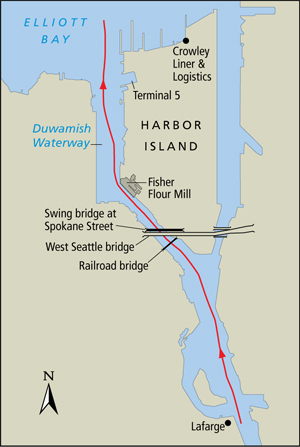 |
|
Forest Trader’s transit on the Duwamish is depicted by a red trackline from the Lafarge cement terminal. |
It was approaching dusk when pilot trainee Capt. Matt Miller ordered Guard and Protector, positioned with a line on the stern, to back easy off the dock. It didn’t take long to bring the empty ship into the channel. “Can I get both boats to stop and stretch?” Miller asked once the bulker was in position.
Guard took a centerline position in front of the bow, while Protector lined up centerline aft. The transit required Protector to pull the ship toward Elliott Bay while Guard maneuvered the bow to keep it squarely within the channel. Miller alternated between requests for Protector to back easy or back one-third for much of the voyage, orders that kept the vessels moving at about 2 knots.
Miller used downtown Seattle’s skyline to orient Guard’s position. If he wanted the ship to move toward the river’s east bank, he’d call “toward town,” while a move toward the left bank meant an “away from town” request. Miller confirmed the process before Forest Trader got underway.
The Markey winch on Guard’s stern kept the 9-inch Samson AmSteel-Blue hawser line tight and responsive while Wingate steered the tug. Depending on the command, Wingate moved constantly from one side of the bulbous bow to the other. The actions kept the bow, and consequently the stern, well inside the channel.
“I like a tight line for the quick reaction,” he said as he maneuvered around the bow. “I like to give it a little pull and put a little tonnage on the line. It kind of helps center the bow and holds it in the center of the waterway.”
 |
|
Guard’s 9-inch Samson line is stretched before spinning the bulk carrier in Elliott Bay. Downtown Seattle is in the background. |
“The line is doing most of the work right now,” he added. “If you see the tires (fendering) squish a little bit, that means we are pushing a little.”
The vessels slowed as they approached a turning basin alongside Ash Grove Cement, where the Duwamish splits into a “Y.” Protector slowed to about 1 knot while Guard pulled the ship’s bow more or less east “toward town.” Forest Trader would pass through the west side of the split, through a series of bridges barely 500 feet apart.
The 92-year-old Duwamish River Bridge was first. The opening of the steel bascule railroad span is just 150 feet wide. Forest Trader, meanwhile, has a 94.5-foot beam. Miller moved to a bridge wing for a better look during the transit. He also relied on Guard and Protector to check distances from the bridge’s protective walls.
The railroad bridge leads right to the Spokane Street Bridge, which carries vehicular traffic toward the port and into neighborhoods in West Seattle. The swing bridge is comparatively roomy with a 250-foot opening. Miller, with help from both tugs, got through both spans without issue.
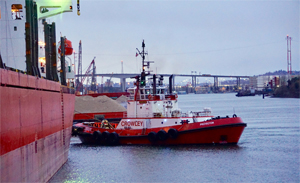 |
|
The stern is the working end for Protector-class tugboats Guard and Protector, which has its line on the stern of Forest Trader. |
Protector, helmed by Capt. Dave Williams, backed easy through the bridges. The former Fisher flour mill was about 1,500 feet ahead. A minute or so later, Forest Trader rounded the elbow turn leading to the wider portion of the west waterway. The radio chatter quieted considerably.
“Out here there are not a lot of commands,” Wingate said as the vessels passed Vigor’s yard.
Wingate is a veteran captain who has spent more than three decades with Crowley. He came aboard Guard four years earlier after stints on other tugs, including the z-drive Tioga — a vessel he likened to a “hot rod.”
“Years ago I would have said, ‘I love the way a boat drives.’ Now, I like the way you live on a boat, the comfort of a boat. This is a comfortable boat to work on,” he said of Guard.
AB Benge Deraco, who was off watch down below, finished making the crew dinner as Forest Trader continued toward open water. The menu for that evening consisted of Chilean sea bass, sauteed prawns, rice and a garden salad.
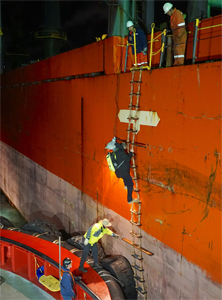 |
|
Puget Sound Pilots President Eric vonBrandenfels, standing on Guard’s fendering, assists pilot trainee Capt. Matt Miller down the ladder from Forest Trader. Guard chief engineer Randy Walker prepares to help both men onto the tug. |
Protector pulled Forest Trader around Harbor Island into Elliott Bay, then hauled in its line. Wingate stretched Guard’s line to about 150 feet and then backed the tug, spinning Forest Trader nearly 180 degrees for the northbound transit out of Puget Sound.
Guard stood by for the pilot transfer after Protector moved on to its next job. Capt. Eric vonBrandenfels, president of the Puget Sound Pilots, climbed down the ladder first as chief engineer Walker helped him aboard the tug. Miller followed moments later. Another pilot stayed aboard for the bulker’s transit to Port Angeles, where the pilot station is located.
On the way back to the dock, vonBrandenfels discussed heightened concerns about coronavirus among some pilots and foreign mariners arriving in U.S. ports. He described steps the pilots were taking to stay safe from a virus that, at that point, was still a mystery.
Little did anyone know, on that late February night, how much the nation, the world and the maritime industry were about to change.

